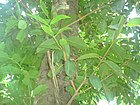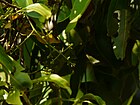Note: This is a project under development. The articles on this wiki are just being initiated and broadly incomplete. You can Help creating new pages.
Difference between revisions of "Syzygium cuminii"
(Created page with "{{stub}} ==Uses== {{Uses|}}, {{Uses|}}, {{Uses|}}, {{Uses|}}, {{Uses|}}, {{Uses|}}, {{Uses|}}, {{Uses|}}, {{Uses|}}, {{Uses|}}, {{Uses|}}.<ref name="Uses"/> ==Parts Used== {{...") |
(→References) |
||
| (2 intermediate revisions by the same user not shown) | |||
| Line 1: | Line 1: | ||
| − | + | [[File:Jambolão e Mosca.JPG|thumb|right]] | |
| + | '''Jambolan''' is a fast-growing, attractive, compact, evergreen shrub or tree with a dense, frondose crown. It usually grows 10 - 15 metres tall, but can reach a height of up to 35 metres. The straight bole is short, stout, and low branched, usually around 40 - 100cm in diameter. | ||
==Uses== | ==Uses== | ||
| − | {{Uses|}}, {{Uses|}}, {{Uses|}}, {{Uses|}}, {{Uses|}}, {{Uses|}}, {{Uses|}}, {{Uses|}}, {{Uses| | + | {{Uses|Diabetes}}, {{Uses|Dysentery}}, {{Uses|Hyperglycaemia}}, {{Uses|Glycosuria}}, {{Uses|Wounds}}, {{Uses|Irregular menstruation}}, {{Uses|Diarrhoea}}, {{Uses|Dysentery}}, {{Uses|Mouth ulcers}}.<ref name="Uses"/> |
==Parts Used== | ==Parts Used== | ||
| − | {{Parts Used|}}, {{Parts Used| | + | {{Parts Used|Fruits}}, {{Parts Used|Branchs}}, {{Parts Used|Bark}}. |
==Chemical Composition== | ==Chemical Composition== | ||
| − | <ref name="chemical composition"/> | + | It contains antianaemic, gingivititis, antidiarrhieal, antipyretic, antibacterial, antineoplastic, antiinflammatory, hypoglycemic, gastroprotective and hypolipidemic activities of phytochemicals.<ref name="chemical composition"/> |
==Common names== | ==Common names== | ||
| Line 16: | Line 17: | ||
===Dravya=== | ===Dravya=== | ||
===Rasa=== | ===Rasa=== | ||
| − | |||
===Guna=== | ===Guna=== | ||
| Line 29: | Line 29: | ||
==Habit== | ==Habit== | ||
| − | {{Habit|}} | + | {{Habit|Evergreen shrub}} |
==Identification== | ==Identification== | ||
| Line 48: | Line 48: | ||
==Mode of Propagation== | ==Mode of Propagation== | ||
| − | {{Propagation|}} | + | {{Propagation|Air layering}}, {{Propagation|Seeds}}, {{Propagation|Grafting}}. |
==How to plant/cultivate== | ==How to plant/cultivate== | ||
| − | <ref name="How to plant/cultivate"/> | + | A plant of the tropics and subtropics, where it is found at elevations up to 2,000 metres. It grows best in areas where annual daytime temperatures are within the range 20 - 32°c, but can tolerate 12 - 48°c. Mature growth can be killed by temperatures of -2°c or lower, whilst young growth is killed at -1°c.<ref name="How to plant/cultivate"/> |
==Commonly seen growing in areas== | ==Commonly seen growing in areas== | ||
| Line 58: | Line 58: | ||
==Photo Gallery== | ==Photo Gallery== | ||
<gallery class="left" caption="" widths="140px" heights="140px"> | <gallery class="left" caption="" widths="140px" heights="140px"> | ||
| − | + | Jaam tree3.JPG | |
| + | Jaambu (Gujarati- જાંબુ) (3167062896).jpg | ||
| + | Jaman (Punjabi- ਜਾਮਣ) (3167203702).jpg | ||
| + | Jambhul tree leaves 1.jpg | ||
| + | Jambolão e Mosca.JPG | ||
| + | Jamun - Syzygium cumini-6.JPG | ||
</gallery> | </gallery> | ||
| Line 64: | Line 69: | ||
<references> | <references> | ||
| − | <ref name="chemical composition">[ | + | <ref name="chemical composition">[http://www.foodandnutritionjournal.org/volume5number1/physicochemical-and-nutritional-characterization-of-jamun-syzygium-cuminii/ Chemical constituents]</ref> |
| − | <ref name="Leaf">[ | + | <ref name="Leaf">[Morphology]</ref> |
| − | <ref name="How to plant/cultivate">[ | + | <ref name="How to plant/cultivate">[http://tropical.theferns.info/viewtropical.php?id=Syzygium+cumini Cultivation details]</ref> |
<ref name="Uses">Indian Medicinal Plants by C.P.Khare</ref> | <ref name="Uses">Indian Medicinal Plants by C.P.Khare</ref> | ||
</references> | </references> | ||
==External Links== | ==External Links== | ||
| − | * [ ] | + | * [https://indiabiodiversity.org/species/show/31820 Syzygium cuminii on indiabiodiversity.org] |
| − | * [ ] | + | * [http://www.foodandnutritionjournal.org/volume5number1/physicochemical-and-nutritional-characterization-of-jamun-syzygium-cuminii/ Syzygium cuminii on foodandnutritionjournal.org] |
| − | + | ||
[[Category:Herbs]] | [[Category:Herbs]] | ||
Latest revision as of 16:27, 14 August 2020
Jambolan is a fast-growing, attractive, compact, evergreen shrub or tree with a dense, frondose crown. It usually grows 10 - 15 metres tall, but can reach a height of up to 35 metres. The straight bole is short, stout, and low branched, usually around 40 - 100cm in diameter.
Contents
- 1 Uses
- 2 Parts Used
- 3 Chemical Composition
- 4 Common names
- 5 Properties
- 6 Habit
- 7 Identification
- 8 List of Ayurvedic medicine in which the herb is used
- 9 Where to get the saplings
- 10 Mode of Propagation
- 11 How to plant/cultivate
- 12 Commonly seen growing in areas
- 13 Photo Gallery
- 14 References
- 15 External Links
Uses
Diabetes, Dysentery, Hyperglycaemia, Glycosuria, Wounds, Irregular menstruation, Diarrhoea, Dysentery, Mouth ulcers.[1]
Parts Used
Chemical Composition
It contains antianaemic, gingivititis, antidiarrhieal, antipyretic, antibacterial, antineoplastic, antiinflammatory, hypoglycemic, gastroprotective and hypolipidemic activities of phytochemicals.[2]
Common names
| Language | Common name |
|---|---|
| Kannada | |
| Hindi | |
| Malayalam | |
| Tamil | |
| Telugu | |
| Marathi | |
| Gujarathi | |
| Punjabi | |
| Kashmiri | |
| Sanskrit | |
| English |
Properties
Reference: Dravya - Substance, Rasa - Taste, Guna - Qualities, Veerya - Potency, Vipaka - Post-digesion effect, Karma - Pharmacological activity, Prabhava - Therepeutics.
Dravya
Rasa
Guna
Veerya
Vipaka
Karma
Prabhava
Habit
Identification
Leaf
| Kind | Shape | Feature |
|---|---|---|
Flower
| Type | Size | Color and composition | Stamen | More information |
|---|---|---|---|---|
| {{{5}}} |
Fruit
| Type | Size | Mass | Appearance | Seeds | More information |
|---|---|---|---|---|---|
Other features
List of Ayurvedic medicine in which the herb is used
Where to get the saplings
Mode of Propagation
Air layering, Seeds, Grafting.
How to plant/cultivate
A plant of the tropics and subtropics, where it is found at elevations up to 2,000 metres. It grows best in areas where annual daytime temperatures are within the range 20 - 32°c, but can tolerate 12 - 48°c. Mature growth can be killed by temperatures of -2°c or lower, whilst young growth is killed at -1°c.[4]
Commonly seen growing in areas
[[:Category:Herbs that are commonly seen in the region of |]], [[:Category:Herbs that are commonly seen in the region of |]], [[:Category:Herbs that are commonly seen in the region of |]], [[:Category:Herbs that are commonly seen in the region of |]], [[:Category:Herbs that are commonly seen in the region of |]].
Photo Gallery
References
- ↑ Indian Medicinal Plants by C.P.Khare
- ↑ Chemical constituents
- ↑ [Morphology]
- ↑ Cultivation details
External Links
- Ayurvedic Herbs known to be helpful to treat Diabetes
- Ayurvedic Herbs known to be helpful to treat Dysentery
- Ayurvedic Herbs known to be helpful to treat Hyperglycaemia
- Ayurvedic Herbs known to be helpful to treat Glycosuria
- Ayurvedic Herbs known to be helpful to treat Wounds
- Ayurvedic Herbs known to be helpful to treat Irregular menstruation
- Ayurvedic Herbs known to be helpful to treat Diarrhoea
- Ayurvedic Herbs known to be helpful to treat Mouth ulcers
- Herbs with Fruits used in medicine
- Herbs with Branchs used in medicine
- Herbs with Bark used in medicine
- Habit - Evergreen shrub
- Index of Plants which can be propagated by Air layering
- Index of Plants which can be propagated by Seeds
- Index of Plants which can be propagated by Grafting
- Herbs that are commonly seen in the region of
- Herbs






